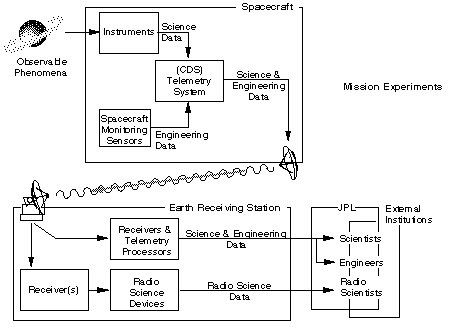Communications SystemHow does NASA communicate with spacecraft? |
Deep space communication antennas and receivers detect many different kinds of natural emitters of electromagnetic radiation, including the stars, the Sun, molecular clouds, and gas giant planets such as Jupiter. Although these sources do not emit at truly random frequencies, without sophisticated signal processing their signals appear as noise. This noise must be separated out in order to process the received signal.
Once that is done, the data received at the antennas of the DSN and properly filtered, flows through a string of computers and communications links known collectively as the Ground Data System (GDS). The functions of the GDS can be viewed as generally divided into two segments: front end and back end.
Front end processing makes the data usable for scientists or engineering. It consists of frame-synchronizing the data stream, restoring the formats created by the spacecraft computers, and providing real-time visibility of engineering and tracking data for analysts and science instrument teams.
Back end processing is use of the data. It consists of data management, data products production, and data access systems. While there typically is some front-end visibility into the science data in real time, it is mainly through the back end systems that science teams (for whom the missions are flown) are formally given access to complete sets of their science data.

Figure from NASA's Jet Propulsion Laboratory's publication: Basics of Space
Flight Learner's Workbook. http://www-b.jpl.nasa.gov/basics/
![]()
How is data put on radio waves?
What is the Deep Space Network?
What interferes with communications?
How often is DS1 in communication with Earth?
![]()
What kind of data is DS1 sending back?
How are gaps in data dealt with?
What kinds of antennas are there?
Why does the data transfer rate have to drop with distance?
How much data is DS1 able to transfer?
![]()
![]()